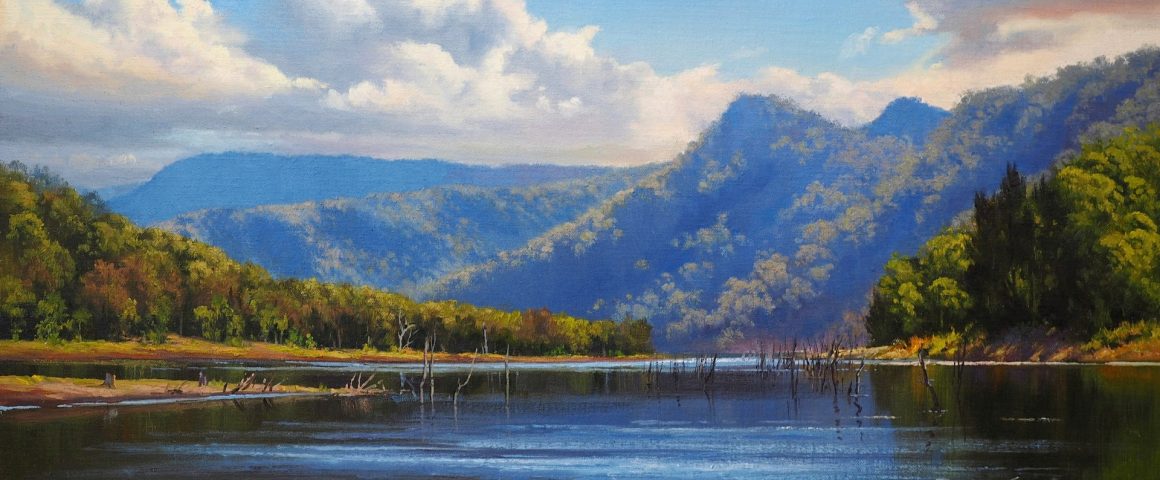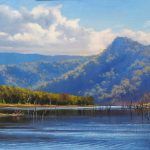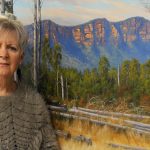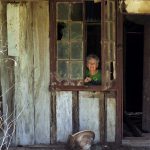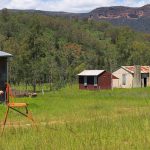“PAINTINGS FROM BURRAGORANG – THE LOST VALLEY”
I’m a wilderness artist and have been painting for 40 years. I love to paint remote places anywhere in Australia and I’ll do anything from bushwalking, trekking or abseiling to find them.
As a child I was brought up by parents who loved bushwalking – a mother who loved snakes – not surprisingly, I was a WIRES snake catcher for many years. My father was a charismatic and well-known Sydney artist – hence my love of painting.
I have no complex story to explain my paintings. I simply want to remind people of the immense beauty and fragility of our environment and hope that they will be moved to deeply consider this when they experience these places through my work – places they may not ever have the opportunity to visit.
The Burragorang Valley is all of the above. It is both history and wilderness and has provided me with a source of artistic material available to very few artists over many years – most recently, only after scaling a mountain of red tape!
Mention the word ‘Burragorang Valley’ and many people today would find it hard to tell you where it is or its significance.
Its significance is easy – it was, as Bob Brown says ‘drowned’ by the building of the Warragamba Dam in the late 1950s – the rising waters of now Lake Burragorang supplying Sydney’s rising population with the water it needed.
To say that it is less than 100 kilometres from the Sydney CBD gives such a false impression of its proximity and access. The unrelenting cliff lines which embrace the Burragorang also provide the geographical barrier which made access for early 19th century settlers almost overwhelming.
‘Burragorang’ is an Aboriginal word which means ‘home or place of the giant Kangaroo’. In fact, it was the Burragorang Aborigines who first gave early Sydney settlers a clue to the existence of this undiscovered valley.
As Jim Barrett documents in his book ‘Life in the Burragorang’, two bulls and four cows strayed from the Government farm in Parramatta in 1788 and were lost. In 1795, Aborigines from the western districts came to Sydney to join the local natives in corroboree in which they danced about strange, large animals with horns and a terrible roar. Shortly afterwards Governor Hunter set out from Parramatta and after two days found 61 cattle grazing in the Narellan Creek area which he then named Cow Pastures. In 1796, George Bass was the first white man to scale the perpendicular mountains and abseil down precipices into the isolated Burragorang Valley. The Gundungurra people had lived there for over 40,000. Through white settlers in the early 1800’s, the Burragorang became a thriving community. Farms, churches, guesthouses and homes nestled beneath the walls of a magnificent mountain range. The decision to build Warragamba Dam, damming five rivers, would change the lives of all of those living in the Burragorang for ever. Their land and businesses would be resumed – the local Aborigines would be relocated to La Peruse – and residents would be forced to leave, either because of inundation or because the flood waters would cut off access to their properties. Having met some of these former residents of the Burragorang recently, I can sense and share their continuing sadness at having to leave their beloved valley.
My relationship with the Burragorang began with a visit to Yerranderie in 1973 arranged by a talented woodcarver who was Head of Forestry with the Sydney Water Board. Yerranderie, once a prosperous silver mining town went into decline in the 1930s and was struck a final blow when it was cut off from Camden by the flooding of the valley. Then, it was a true ghost town and looked very much as it had when abandoned in the 1950s. These days, Yerranderie is more accessible to visitors since being entrusted to the National Parks and Wildlife Service.
It wasn’t until the mid 1980s when I was looking for a new direction with my painting that I jumped at the chance, again with the Water Board rangers to revisit the Burragorang Valley. When I did, I discovered that much of the landscape that I had assumed had vanished, was actually above the water providing the catchment for Lake Burragorang.
I was so privileged during this decade to visit the enigmatic and beautiful place as often as I wished. I almost became the resident artist for the now Metropolitan Water and Sewerage Board! I held two major sell-out exhibitions and my paintings were also collected by the Board to hang in their offices.
During the 1990s I made only one visit to the Burragorang’s Nattai area and I realised that access was now becoming much more difficult. During this decade I had begun to bushwalk and the desire to visit Australia’s remote places and champion the challenge to protect our environment also grew.
For nearly 20 years the Burragorang was a heartfeltproject- but now remote memory as I travelled extensively through Australia painting the Kimberley, Australia’s islands amdn many other remote areas of our vast continent.
However, in 2014, as life would have it, I was ‘brought back’ to the Burragorang and the spark of an idea for one last exhibition – and even perhaps a book of my paintings – was ignited – and grew!
Official access was now almost impossible and had it not been for my previous long association with the Water Board, I feel it would not have been granted.
Ultimately, between 2014 and 2016, and after numerous telephone calls, letters and submissions to the appropriate government department I made three visits into the valley and was ultimately granted a boat trip – provided I could swim 25 metres fully clothed and knew what to do should we collide with a whale!
Much of the time I was filled with a gnawing apprehension. Many times the weather was against me. The landscape of Burragorang had also changed considerably. Since the brumbies had been moved out of the Valley by Luke Carlon, a great great grandson of the Carlons of the Burragorang, (documented in Luke’s epic film “The Man from Cox’s River”), the natural vegetation had reclaimed much of the landscape. Where once sandy banks reached out into shallow water framing a backdrop of mountain ranges, now thick tea tree, wattle and low scrub blocked my view. Would I have enough variety in the material for my exhibition?
Because of the delay in gaining access to the Valley and the delays due to bad weather, my exhibition date was moved from March, 2017 to March, 2018, to enable me to paint the number of paintings necessary for a major solo exhibition and to bind them, along with some historical black and white photographs of the Burragorang before flooding, into my book.
Ultimately, however, after such a long absence, I felt the delicious excitement and familiarity of being back in the Burragorang. I saw individual trees that I painted 35 years ago still standing, still recognisable, like seeing old friends. I saw familiar mountain peaks that I have been able to reference in old photographs of the area before inundation, leaving me with a feeling of wonder. I witnessed the now empty landscape where buildings once stood and the derelict shearing sheds and out buildings of Jooriland Homestead – a poignant reminder of the people who had once lived here.
However, it was the sense of finality which overwhelmed me when it came time to leave afrer my last visit – ironically this was the boat trip I badly needed for my exhibition on the now Lake Burragorang. I knew I must accept that there would probably not be another opportunity to stand in the Burragorang Valley and just for a moment, appreciate life as it was before inundation.
So much was lost and so much more will be should the NSW Government continue to move forwar with raising the Dam wall. Knowing the wilderness that is still there and priceless Aboriginal heritage, that would be an incomprehensible tragedy. For those interested in find out more, the Colong Foundation is running the “Save the Wild Rivers’ Campaign.
- Brumby Country – Apple Tree Flat
- In studio with The Old Pine and Poplar Plantation
- Jorriland Outbuilding
- Air Painting in Burragorang Valley
Robyn Collier’s Exhibition and book launch “ Burragorang, the Lost Valley” will open at The Lost Bear Gallery, 98 Lurline Street, Katoomba on Saturday, 24th March, 2018 at 3.30pm. It will run until Thursday 26th April.
This will be Robyn’s final exhibition on the Burragorang Valley.


